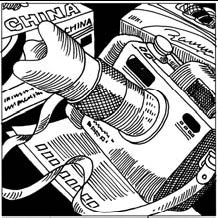Liang Hongfu
Waking up to high quality made-in-China
By Hong Liang (China Daily)
Updated: 2007-04-03 06:58
 |
Large Medium Small |
Pride of ownership has become a cliche frequently cited to explain aficionados paying big money for something that's as unnecessary as an ornate wristwatch or as obsolete as a mechanical range-finder camera. But behind this cliche lies a passion that we can all share, a deep respect for, and appreciation of, excellence in workmanship. It is manifested in the uncompromising quality of the product, which may seem to others outrageously overpriced and laughably impractical.
At a camera market in Shanghai one Saturday afternoon, I was introduced to pride of ownership in the form of a $200 ball head for a tripod mount, which was satiny in both touch and operation. An experienced photographer would certainly appreciate the precision of its movements and the rigidity of its locking mechanism.
 Assuming that it was an import, I enquired about its country of origin. Pointing to the "Made in China" engraved on the rim of the metal base plate, the shopkeeper, a middle-aged man, said blandly that the product was fabricated in a small Shenzhen factory well-known in the industry for its meticulous attention to quality.
Assuming that it was an import, I enquired about its country of origin. Pointing to the "Made in China" engraved on the rim of the metal base plate, the shopkeeper, a middle-aged man, said blandly that the product was fabricated in a small Shenzhen factory well-known in the industry for its meticulous attention to quality.
"Made in China" has been generally taken to mean mass-produced, low-tech and low-priced merchandise. But there are pockets of excellence, like this little Shenzhen factory, in the country's amazingly vast and uniformly dull industrial landscape. These pockets keep the beacon of quality and workmanship alight.
The combined output of these specialist manufacturers is too small to be of any relevance to the national account. But their reputations in their fields could bring respect and trust to the "Made in China" label.
Just listen to how a thoroughly jaded reviewer at a leading US magazine for hi-fi enthusiasts raved about a new amplifier designed and manufactured by Spark of Zhuhai in China's Guangdong Province. The amplifier, he wrote, "is a lushly chromed chassis with a terraced aluminum alloy faceplate, sculpted housings for the mains and output transformers, and a thickly enameled protective cage that fits so beautifully, you'd think someone actually cares whether or not you like it."
Admiring the "neat" wiring and "saintly" soldering, indications of superb workmanship, the reviewer gushed: "Inside my review sample there were no rough metal edges, no questionable solder joints, and not so much as a speck of dust."
After a prolonged period of critical listening, the reviewer said of the $3,000 Spark amplifier: "You could live with this forever." Before I read his piece, I never knew that something "Made in China" could be this good in design, workmanship and function.
In many instances, Chinese products are let down by their unimaginative packaging, which, in some extreme cases, can be downright shoddy. But apparently there are exceptions.
A relatively inexpensive ($1,500) integrated amplifier produced in Panyu, also in Guangdong Province, arrived at the home of a reviewer of another audio magazine encased in "the most elaborate foam and double boxing" the recipient had ever come across. Such additional protection was needed for the delicate tubes used to drive the machine's electronics. The reviewer was obviously impressed.
Through their own efforts, these Chinese manufacturers have shown that they can give their Western competitors a run for their money even in the arcane world of high-end audio, where exacting standards of design quality are paramount. This is a significant achievement because it reaffirms the notion that Chinese manufacturers, especially those in the private sector, have the design capability and production resources to compete with the best in the world.
E-mail: jamesleung@chinadaily.com.cn
(China Daily 04/03/2007 page10)
| 分享按钮 |